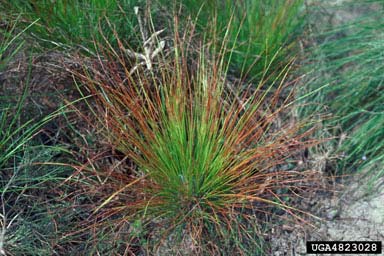
Importance: Longleaf pine is the only species in the South damaged by brown spot needle blight (Scirrhia acicola.) Seedlings are often heavily infected while in the grass stage and often die after repeated defoliations. Nursery grown longleaf pine seedlings are particularly susceptible.
Identification: Boat-shaped spores are produced in yellow bands on the needles. Examining the spores under a microscope may make positive identification.
Signs of Attack: The most common symptom is dead needles of seedlings and small saplings. The seedling appears dead, but close examination will usually reveal a green and healthy bud. Infected needles develop gray-green spots, which later turn brown. Eventually, a yellow band develops on the needle. The affected area increases in size, resulting in the death of the needle. After a few months later, the sexual spores mature and spread to other seedlings. No other host is required for successful infection. The asexual spores mature in the needle and are exuded as a gelatinous mass. The washing or splashing action of rainwater, usually in the late spring, spreads them. When weather conditions are favorable, this disease spreads rapidly and infects large areas.
Control: The simplest method of preventing loss of naturally regenerated longleaf pine to this disease is the use of prescribed fire. Prescribe burning every two or three years is effective in destroying the infected needles and killing the spores. Artificially regenerate longleaf pine by planting disease-free seedlings on a wide (l0' x l0’) spacing and follow with a prescribed burning program. County foresters can visit your property and give a stand management recommendation specific to your stand. In locations where prescribed burning is undesirable or not possible, the use of fungicide sprays can be used to control the fungus. Residential houses, landscape plantings, and small fields are examples of where fungicide spraying can be applicable. Utilize a licensed and professional pesticide applicator to conduct the treatment. Another means of suppressing brown spot needle blight is to use resistant stock. Seed from resistant longleaf stock are available in limited quantities, but should become more readily available in the future.
Photo Credit: Edward L. Barnard, Florida Department of Agriculture and Consumer Services, ForestryImages.org
Additional Resources